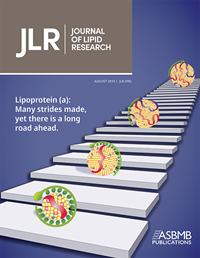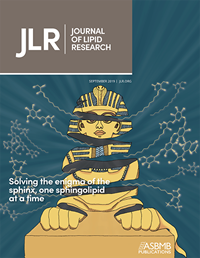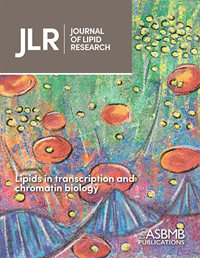JLR junior associate editors organize virtual issues
The junior associate editors of the Journal of Lipid Research have organized four virtual issues highlighting cutting-edge research published by the journal.

Lipoprotein (a): Many strides made, yet there is a long road ahead
In this virtual issue, the JLR highlights early-career researchers pushing our understanding of lipoprotein (a) pathophysiology forward. According to Gissette Reyes-Soffer of the Columbia University Irving Medical Center, a better grasp of lipoprotein (a) is necessary to improve risk evaluations and targeted therapies for cardiovascular disease and diabetes.
The cover art depicts the Lp(a) particle following the steps of a walking path, increasing in size as the road goes into infinity. Read the collection.

Solving the enigma of the sphinx, one sphingolipid at a time
Recent studies have advanced our understanding of sphingolipids and their biologic roles in health and disease. This virtual issue, organized by Rotonya Carr of the University of Pennsylvania Perelman School of Medicine, also highlights both established and new investigators in the field who undoubtedly are the future of sphingolipid research.
The cover art features the structures of several sphingolipids being freed as the Sphinx unravels. Read the collection.
Exploring the nuances and complexity of lipoprotein clearance
This virtual issue, assembled by Brandon Davies of the University of Iowa Carver College of Medicine, highlights studies that advance our understanding of lipoprotein clearance and illustrate the breadth and diversity of lipoprotein-clearance research.
The cover art depicts different mechanisms acting to clear and modify lipoproteins on an assembly line representing the circulation. Read the collection.

Lipids in transcription and chromatin biology
Ray Blind of the Vanderbilt University School of Medicine put together a virtual issue showcasing recent papers showing that lipids actively participate in epigenetic reprogramming, chromatin modifications and nucleosome structure, along with their more well-established roles in splicing, RNA export and transcriptional regulation.
The cover art is an abstract representation of nuclear lipids participating in the regulation of transcription and chromatin biology. Read the collection.
Enjoy reading ASBMB Today?
Become a member to receive the print edition four times a year and the digital edition monthly.
Learn moreGet the latest from ASBMB Today
Enter your email address, and we’ll send you a weekly email with recent articles, interviews and more.
Latest in Science
Science highlights or most popular articles

Mapping proteins, one side chain at a time
Roland Dunbrack Jr. will receive the ASBMB DeLano Award for Computational Biosciences at the ASBMB Annual Meeting, March 7–10, just outside of Washington, D.C.

Exploring the link between lipids and longevity
Meng Wang will present her work on metabolism and aging at the ASBMB Annual Meeting, March 7-10, just outside of Washington, D.C.

Defining a ‘crucial gatekeeper’ of lipid metabolism
George Carman receives the Herbert Tabor Research Award at the ASBMB Annual Meeting, March 7–10, just outside of Washington, D.C.

The science of staying strong
Muscles power every movement, but they also tell the story of aging itself. Scientists are uncovering how strength fades, why some species resist it and what lifestyle and molecular clues could help preserve muscle health for life.

Bacteriophage protein could make queso fresco safer
Researchers characterized the structure and function of PlyP100, a bacteriophage protein that shows promise as a food-safe antimicrobial for preventing Listeria monocytogenes growth in fresh cheeses.

Building the blueprint to block HIV
Wesley Sundquist will present his work on the HIV capsid and revolutionary drug, Lenacapavir, at the ASBMB Annual Meeting, March 7–10, in Maryland.

